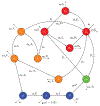Exploring the Impact of Climate Variability on Malaria Transmission Using a Dynamic Mosquito-Human Malaria Model
- PMID: 30906484
- PMCID: PMC6430130
- DOI: 10.2174/1874279301810010088
Exploring the Impact of Climate Variability on Malaria Transmission Using a Dynamic Mosquito-Human Malaria Model
Abstract
Introduction: The reasons for malaria resurgence mostly in Africa are yet to be well understood. Although the causes are often linked to regional climate change, it is important to understand the impact of climate variability on the dynamics of the disease. However, this is almost impossible without adequate long-term malaria data over the study areas.
Methods: In this study, we develop a climate-based mosquito-human malaria model to study malaria dynamics in the human population over KwaZulu-Natal, one of the epidemic provinces in South Africa, from 1970-2005. We compare the model output with available observed monthly malaria cases over the province from September 1999 to December 2003. We further use the model outputs to explore the relationship between the climate variables (rainfall and temperature) and malaria incidence over the province using principal component analysis, wavelet power spectrum and wavelet coherence analysis. The model produces a reasonable fit with the observed data and in particular, it captures all the spikes in malaria prevalence.
Results: Our results highlight the importance of climate factors on malaria transmission and show the seasonality of malaria epidemics over the province. Results from the principal component analyses further suggest that, there are two principal factors associated with climates variables and the model outputs. One of the factors indicate high loadings on Susceptible, Exposed and Infected human, while the other is more correlated with Susceptible and Recovered humans. However, both factors reveal the inverse correlation between Susceptible-Infected and Susceptible-Recovered humans respectively. Through the spectrum analysis, we notice a strong annual cycle of malaria incidence over the province and ascertain a dominant of one year periodicity. Consequently, our findings indicate that an average of 0 to 120-day lag is generally noted over the study period, but the 120-day lag is more associated with temperature than rainfall. This is consistence with other results obtained from our analyses that malaria transmission is more tightly coupled with temperature than with rainfall in KwaZulu-Natal province.
Keywords: Anopheles arabiensis; Climate variability; Malaria dynamics; Malaria incidence; Mathematical model; South Africa.
Conflict of interest statement
CONFLICTS OF INTEREST The authors declare that they have no competing interests.
Figures








References
-
- WHO, 2015. World Malaria Report: World Health Organization 2015. Available from: http://www.who.int/malaria/publications/world-ma.aria-report-2015/report...
-
- Ermert V 2010. Risk assessment with regard to the occurrence of malaria in Africa under the influence of observed and projected climate change.
-
- McCarthy JJ, Canziani OF, Leary NA, Dokken DJ, White KS. Impacts, adaptation, and vulnerability, United Nations Intergovernmental Panel on Climate Change. Clim Change 2001; 2001.
Grants and funding
LinkOut - more resources
Full Text Sources
